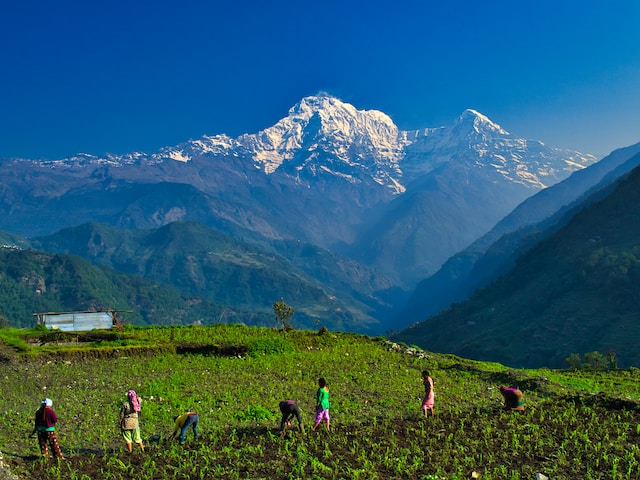

Climate-Smart Agriculture in Action
Produced in partnership with the Global Alliance for Climate-Smart Agriculture (GACSA)
aWhere
Putting Rainfall and Weather Data into Farmers’ Hands
Ghana and Kenya
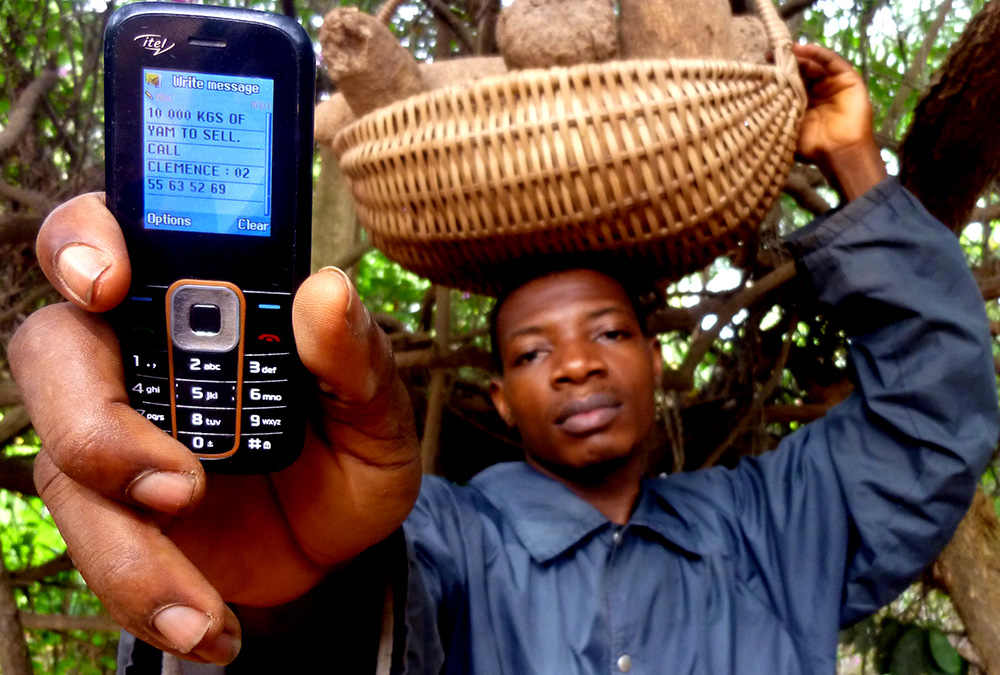
aWhere and Global Development Analytics (GDA) are working to make agricultural meteorological information available and accessible across the value chain, with funding from the Gates Foundation.
In Ghana, the data is used by the information service Esoko, which pushes weather forecasts, climate-smart agricultural tips and market prices to over 20,000 farmers per week by SMS messages. It is backed up by a call centre staffed with agronomists who have access to detailed weather visualizations specific to the caller’s location. “The weather forecasts helped me plan better to take advantage of the rainy season,” comments Nibe-Ib Besane, a farmer from the Lawra District in Ghana.
The iShamba SMS and call centre service also uses aWhere and GDA weather data to provide information to 300,000 registered farmers in Kenya.
This information allows farmers to better plan for planting, input and treatment applications – making farmers more resilient to climate change. The next phase is to time agronomic tips and recommendations with weather and growth stage models. For example, a weeding recommendation can be pushed at stage two of a farmer’s maize plant growth, calculated from their planting date. This increases the effectiveness of these tips and recommendations, as they are more likely to reach farmers at the right time in their cropping season.
To encourage more innovation in this area, aWhere and GDA have been organizing “hackathons” in Africa and South Asia, allowing participants to access aWhere’s weather data. These events bring together local developers, researchers, seed suppliers, buyers, retailers and other agriculture value chain organizations to develop more ways to utilize this data effectively.
Bangladesh Institute of ICT in Development (BIID)
Input and Extension Bundle Boosts Yields
Bangladesh

e-Krishok (meaning electronic farmer) offers information and advisory services through mobile phones and email to farmers and service providers. The service was introduced in Bangladesh in 2008, to address the lack of effective of extension and advisory services in the agricultural sector.
Farmers can receive two SMS messages on a requested topic, or receive a call from a BIID information officer. Topics include how to deal with pests and diseases and optimum fertilizer / pesticide dosages, as well as climate information. Now available to any information centre with internet facilities or a mobile phone, the service has expanded to cover the entire country.
Ekram Hoosain, a farmer from Bagerhat, is pleased with the service. “It was a different experience to get my problems solved over my phone, by which I saved my crop,” he commented. “I never received a solution so quickly. It will be very easy for me now to call e-Krishok and solve problems.”
The content management team continually updates the product, closely considering climate issues. For example, farmers in the Southern delta of Bangladesh are suffering with salinity problems due to rising sea water levels on already saline soils. The e-Krishok team facilitated farmer access to saline tolerant varieties and technologies to ensure increased production and minimal losses.
BIID has recently collaborated with four input companies (primarily involved in seed and crop protection products) to introduce Zero Cost EAS that offers free advice when farmers buy a package of inputs. This service was offered to approximately 22,500 farmers during October 2015 to February 2016 and over half acknowledged the benefits of higher productivity or low production loss.
Photo: BIID
Centre for Agriculture and Biosciences International (CABI)
Plant Clinics Help Farmers to Lose Less and Grow More
Global

Plantwise is a global programme, led by CABI, to increase food security and improve rural livelihoods by reducing crop losses. This is achieved by establishing networks of local plant clinics, run by trained plant doctors, where farmers can find practical plant health advice. Plant clinics are reinforced by the Plantwise Knowledge Bank, a portal with online and offline plant health information, including diagnostic resources, pest management advice and front-line pest data.
Plantwise supports climate-smart agriculture by helping farmers reduce loses and therefore increase their agricultural productivity and incomes without using any additional land or inputs. This in turn improves farmers’ resilience to climate shocks. In this way, Plantwise supports countries in meeting their national food security and development goals.
To date, Plantwise has reached over 4.5 million farmers in 34 countries with actionable plant health information. External evaluations have shown that 92% of farmers visiting plant clinics are satisfied with the advice they are given; on average they share the information with 4 other farmers; and 79% saw their crop yields increase after the plant clinic visit.
Farmers see the benefits. “A few years ago, I would make [ZMK] 5,000-6,000 per year,” comments Kenny Mwansa, a farmer from Rufunsa District, Zambia. “Last year, I got about [ZMK] 15,000. I have never missed any plant clinic session. I have been very committed, very faithful, because I have seen the benefits.”
Government institutions also value Plantwise, and in many cases have embedded it into their national plant health frameworks.
Photo: CABI
CGIAR Research Program on Climate Change, Agriculture and Food Security (CCAFS)
The Power of Intercropping Banana and Coffee
Uganda, Rwanda, Burundi, Democratic Republic of Congo
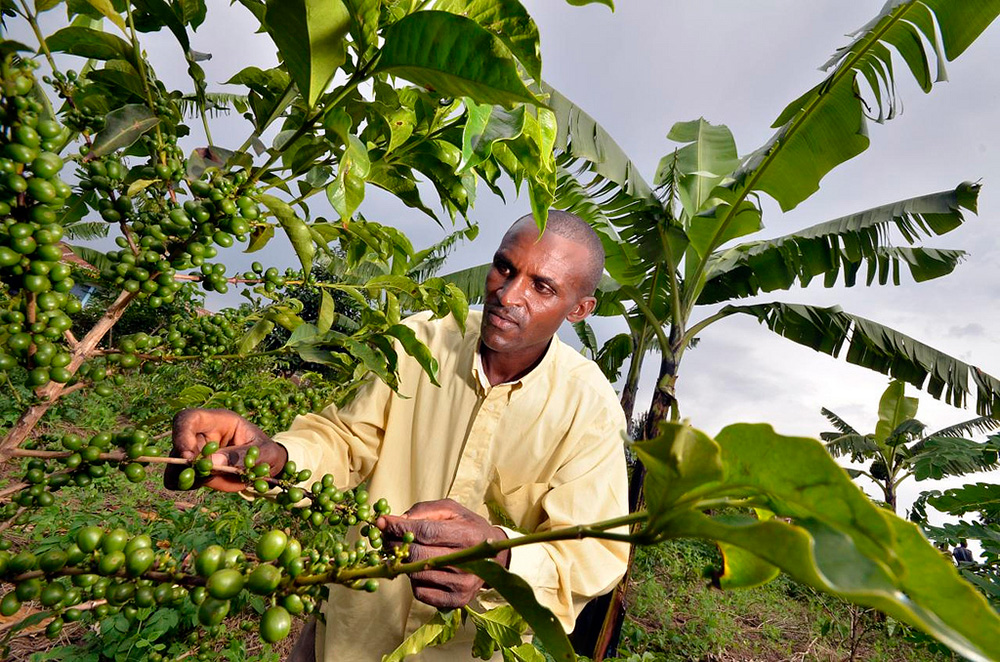
Increasing temperatures are having substantial impacts on the suitability of coffee systems across Eastern and Central Africa. Since 2006, the International Institute for Tropical Agriculture (IITA) has investigated the benefits of the traditional practice of Coffee Banana Intercropping (CBI). On-farm research indicates that growing the two crops together can contribute to all three Climate-Smart Agriculture pillars.
In terms of productivity, CBI increases total revenue per unit area by more than 50% compared to monocropped banana or coffee, without affecting coffee yield. Bananas make coffee production systems more diverse, reducing risk while increasing food security during dry seasons. In newly established coffee farms, bananas can offset cash flow constraints in the early years before the coffee becomes productive.
In terms of resilience, bananas provide valuable shade coverage for highly climate-sensitive coffee crops. In addition, bananas are capable of remaining hydrated under drought stress, reducing water competition during drought, compared to other shade trees.
CBI also mitigates greenhouse gas emissions by increasing above- and below-ground carbon stocks. On average, mixed cropping can sequester around four times the carbon that unshaded monocultures can. Furthermore, the increased productivity of CBI systems reduces overall carbon footprint, as emissions related to agricultural inputs are spread over a larger agricultural output.
In Eastern Uganda, over 85% of coffee farmers have at least one CBI plot. “The results were spectacular,” comments Piet van Asten, a scientist at the International Institute of Tropical Agriculture (IITA) in Kampala, Uganda. “[But] …the downside is that it increases competition among the different plants for water, nutrients and light. This needs to be managed by using good agronomic practices such as integrating fertilizers and organic nutrient inputs, managing plant density and canopy cover appropriately, and practicing good soil and water conservation.”
Photo: Neil Palmer (CIAT)
Chemonics
Promoting SOLID Livelihoods
Sri Lanka
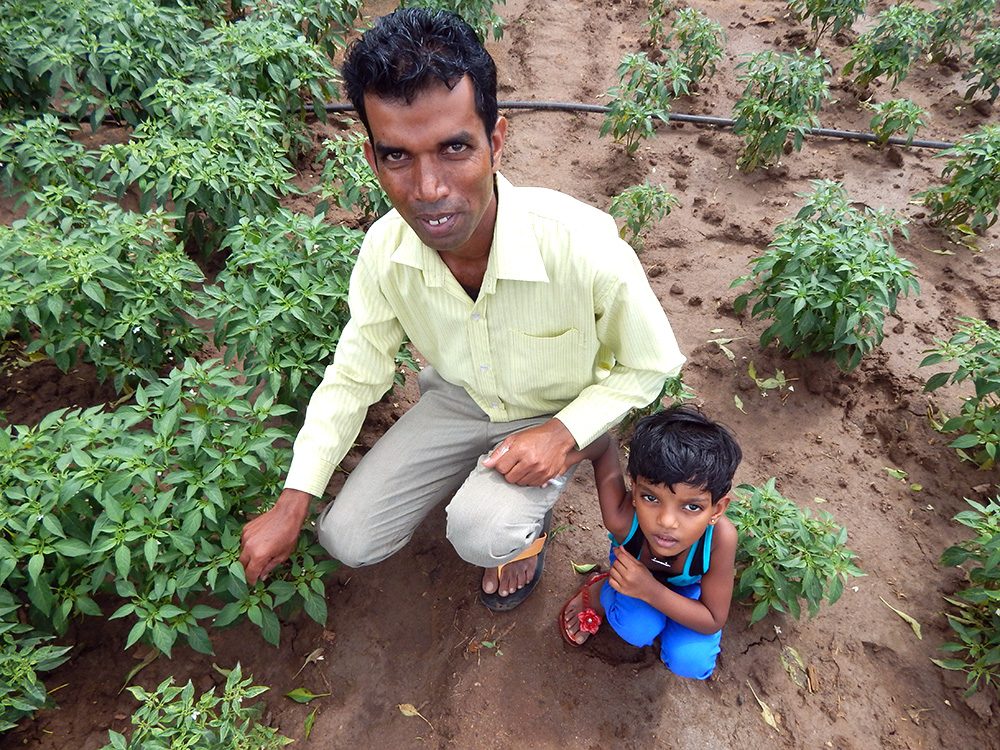
The USAID Sri Lanka Supporting Opportunities in Livelihoods Development (SOLID) project works with rural communities in the Northern, North Central, and Eastern Provinces, with a focus on helping women, youth, and vulnerable populations, to shift from subsistence agriculture to small-scale commercial production.
To improve productivity in the dairy sector and increase farmer resilience to weather variability, SOLID has introduced best practices, like silage production for year-round feed of livestock. As a result, 75% of farmers reported an increase in milk production, with 50% seeing an increase of 20% or more. Some farmers have reduced the size of their herds to focus on achieving better production with fewer animals.
To revive chili cultivation, SOLID introduced new technologies, including off-season chili cultivation utilizing poly bags and sprinkler irrigation systems, to reduce disease and increase yields. Sprinklers help farmers to control the leaf curl virus vector while reducing the cost of irrigation and water usage, versus the traditional technique of flood irrigation, thereby conserving water. With many farmers living in the dry zone, water conservation is vital to maintain consistent agricultural yields.
“I had lost interest in cultivating chili because I didn’t think I could make a good income from it. I heard about the SOLID effort to increase harvests by using new technology,” noted Lasantha Wickramasinghe, a chili farmer from Anuradhapura District. “Many young people were moving away from farming but now they believe they can actually make a profit from it. Initiatives like this will help bring the young back to the farm.”
International Center for Tropical Agriculture (CIAT)
Enhancing Rice Productivity through Big Data Approaches
Colombia
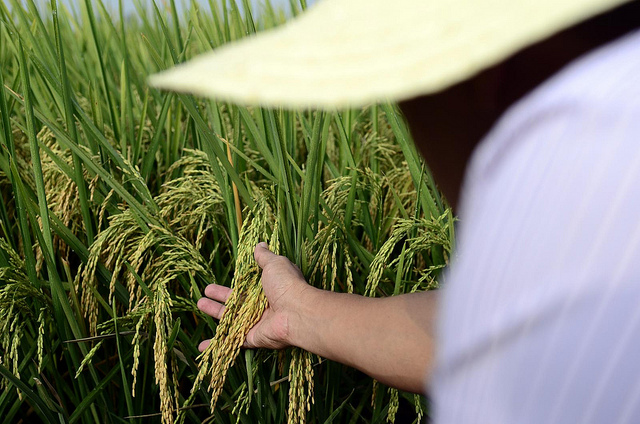
In Colombia, the climate is becoming increasingly unpredictable, particularly with regard to rainfall and temperature extremes. This has resulted in average rice yields falling from six to five tonnes per hectare in less than five years.
It means traditional calendar-based decisions about when to plant are no longer reliable. CIAT scientists mined 10 years of weather and crop data to understand how climatic variation impacts rice yields in the country. In 2014, following roughly a year of data analysis, the team were able to predict a forthcoming drought in the country’s Caribbean department of Córdoba, a major rice-growing area. Using the information, the country’s rice growers’ association recommended that farmers could save themselves from crop failure by not planting rice at all. The drought came, and those who planted harvested nothing, but the 179 farmers who followed the advice, saved approximately USD 3.6 million in averted costs. The following season, again following advance warning – this time of delayed rains – the farmers postponed planting by two months. They were able to produce a good harvest, and take advantage of higher prices. “It turned out perfectly,” commented Oscar Lopez, a rice farmer who benefitted. “We got good production and good prices.”
The project is considered climate-smart because it has helped farmers both adapt to climate variability by helping them plant (or not plant) at the best possible time, and also improve the sustainability of production through “data-driven agronomy”.
This Big Data project has the potential to be scaled-up for application in other countries, thereby increasing agricultural resilience to climate change.
Photo: Neil Palmer (CIAT)
Cool Farm Alliance
Tool To Help Global Farms Keep Their Cool
Global
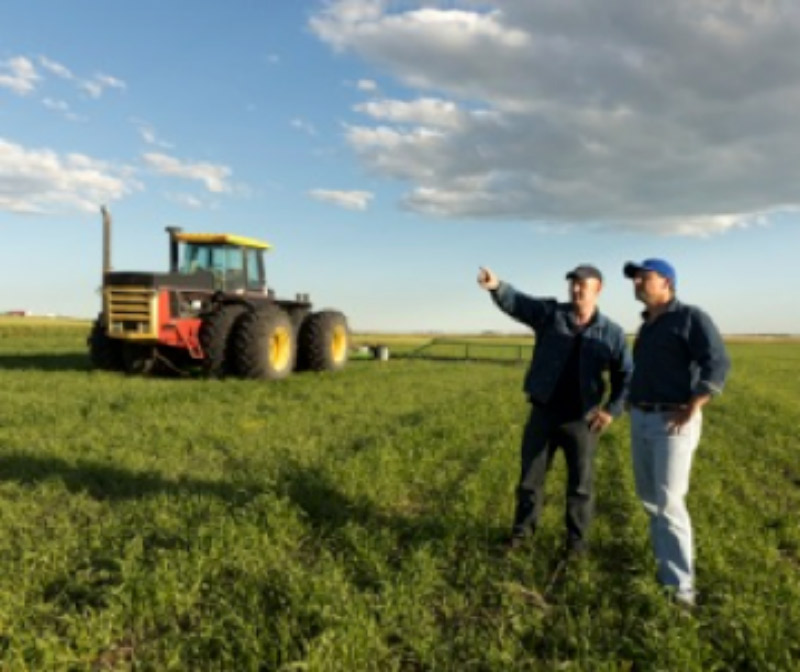
The Cool Farm Tool is an online calculator that enables farmers to measure their greenhouse gas emissions, and understand mitigation options for agricultural production. Originally developed through a partnership between the University of Aberdeen, Unilever and the Sustainable Food Lab, the Tool works by providing growers with the ability to plug in their farm practices and get immediate results and instant feedback on the impact of different farming management options using “what-if” scenarios.
Recommendations include introducing measures that reduce fuel and energy use, as well as introducing cover crops, reducing tillage, tailoring crop rotations and increasing agroforestry. These measures not only remove carbon from the atmosphere, but also help improve soil fertility, increase water retention, reduce erosion from wind and water and improve productivity with reduced inputs – all of which can benefit the farmer.
A tea co-operative in India used the Cool Farm Tool to analyse why yields had been declining by 30-40% over the past 5-10 year period. Based on the results, the cooperative started using crop residues to make compost and apply it to the soil. One year later, production was up by 20% and emissions were down by 30%. Farmers also gained a better understanding of carbon dynamics, and began to utilize local resources that were previously part of a waste stream, increasing water holding capacity in the soil by about 40%.
A number of the world’s largest food and drink businesses and NGOs now cooperate in the Cool Farm Alliance, a membership organization dedicated to spreading the use of the Cool Farm Tool by farmers in order to drive emissions reductions from global agriculture. The tool is now being extended to include modules for measuring water and biodiversity.
Photo: Cool Farm Alliance
CORBANA
Keeping Banana Farmers on Track with Weather Data
Costa Rica

Bananas are a key crop for farmers in the Caribbean basin of Costa Rica, which has 42,916 hectares of banana plantations. Favourable weather and soil conditions usually allow for intensive production for export purposes. However, during the year there are considerable variations in climate that can cause a significant impact on production.
In 2005, the National Banana Corporation (CORBANA) decided to create the BANACLIMA Program, an automated weather station network that distributes weather information to all banana producers and crop managers in real-time, allowing continuous monitoring of weather conditions in the major banana-producing areas in the country. The real-time information is put on CORBANA’s website (www.corbana.co.cr), allowing both producers and farm managers to use it. Weather forecasting is also available via e-mail and SMS. This includes alerts and warnings for extreme weather events, as well as a weekly and monthly agro-climatic bulletin.
“It is a good tool for all us farmers, it really helps the banana growing sector, as a support system that helps us make decisions that will prevent (the weather) from affecting us badly,” comments one BANACLIMA user.
A key benefit of having this weather information available is being able to decide how to manage input use, such as fertilizers and crop protection products, on a farm. Given that the efficiency of these products is highly dependent on the climate conditions, farmers are able to maximize the economic benefit of using these products, whilst minimizing impact on the environment, if they have weather forecasting information available to them.
The availability of weather information will also help the banana industry to better prepare for natural disasters related to climate change such as floods or droughts.
Food, Agriculture, Natural Resources Policy Analysis Network
Measuring Vulnerability to Climate Change in Southern Africa
Lesotho, Malawi, Swaziland and South Africa
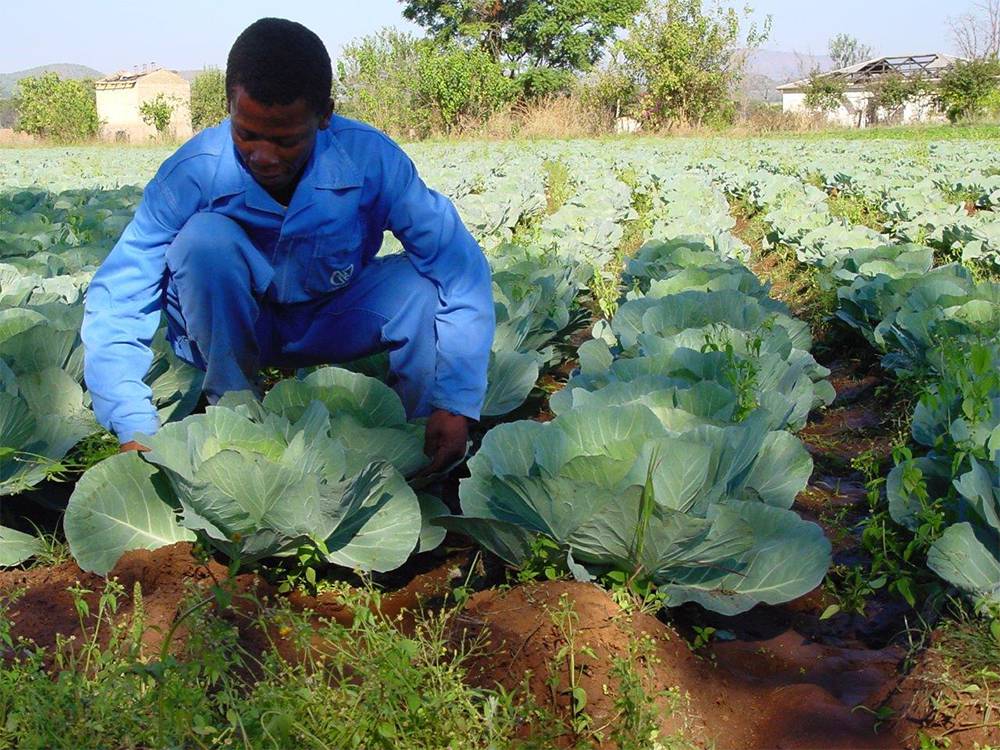
Is it possible to quantify a household’s vulnerability to climate change? FANRPAN has developed a tool that seeks to do just that.
The Household Assets Vulnerability Assessment (HAVA) categorizes a household by assessing “external” vulnerability that is introduced by shocks such as disease and climate change and the “internal” ability of such a household to withstand them. This includes a household’s access to and use of five capital assets: natural, social, physical, human and financial. It then classifies the household into three levels of low, medium and high vulnerability.
By building a detailed picture of which households are vulnerable, and the capital assets they lack, interventions can be developed that are carefully matched to the needs of communities.
Since its creation in 2004, the livelihood data of over 30,000 households in eight southern African countries has been collated. It has been integrated with climate data to determine the most cost-effective climate-smart agriculture policies in Lesotho, Malawi, Swaziland and South Africa. In South Africa, for example, the cost-benefit results suggest households need to move towards the use of drought-resistant crop varieties and conservation farming both in Limpopo and Eastern Cape.
All studies confirmed that the HAVA tool is useful for planning and policy development, because it provides a yardstick for determining the extent of certain social challenges and thus makes it possible to measure the progress of a particular development programme, strategy or policy over time.
As part of FANRPAN’s latest project, Agriculture to Nutrition (ATONU): Improving Nutrition Outcomes through Optimized Agricultural Investments, evidence from the HAVA tool on which agricultural livelihood factors are most important for improving nutrition will be used to inform nutrition-sensitive interventions and advocacy for policy change.
Farm Africa
Irrigation and Diversification Bring Farmers Success
Ethiopia
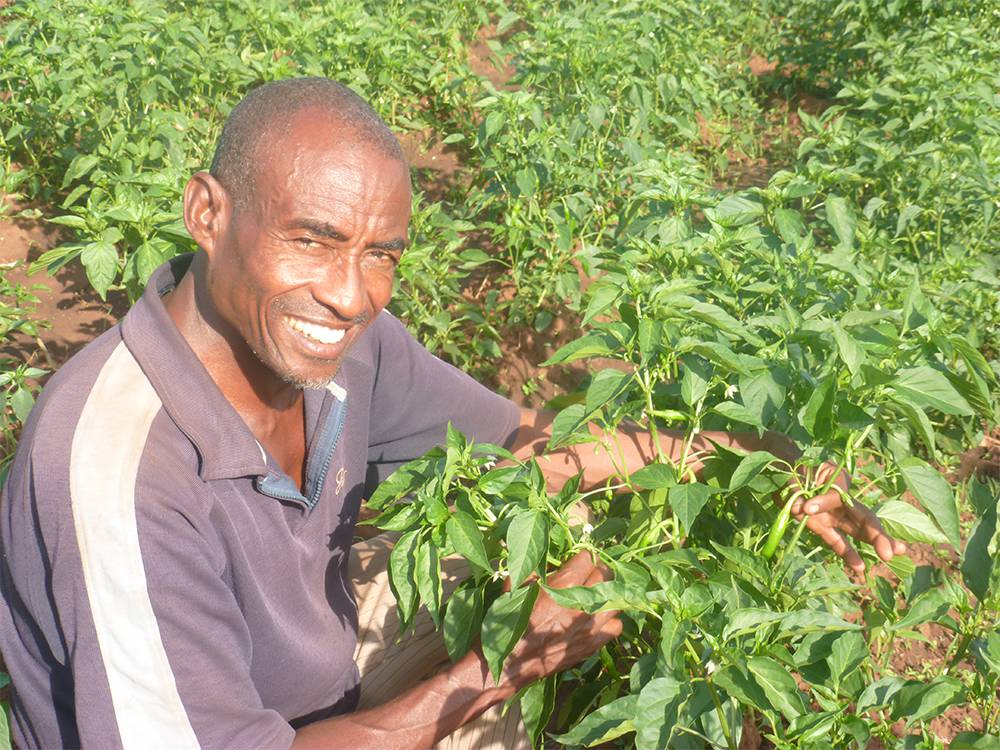
Agriculture in Ethiopia is characterised by small-scale subsistence and rain-fed production systems where crop and livestock yields and economic returns are very low. Without irrigation, smallholders are very vulnerable to the effects of climate change, which is already seen in rising temperatures and possibly also in shifts in rainfall patterns.
The climate-smart agriculture project in the Southern Nation Nationalities Peoples (SNNP) Region of Ethiopia run by Farm Africa and its partners Self Help Africa, SOS Sahel Ethiopia and Vita aims to help more than 44,000 smallholder farmers adopt farming practices that are resilient to climate extremes, boost productivity and help them engage in more profitable value chains.
The project is helping farmers in many ways, including harvesting and storing water for use in irrigation, planting drought-tolerant crops with shorter production cycles and higher yields, and integrating agriculture with drought-tolerant animals such as goats. In addition, the project is building links between farmers and higher value markets.
Bihon Ondaye, from Boloso Bombe woreda, used to produce maize, teff, coffee, haricot beans and ginger, but in 2015 he lost most of his crops due to disease and drought. Farm Africa advised Bihon to start farming pepper, tomatoes, cabbages and onions using irrigation.
Despite initial apprehension, Bihon realised that climate-smart agricultural techniques only involve small changes to traditional farming, yet have the potential to both save him energy and significantly boost yields. He now has fields full of crops, and is optimistic he will be able to achieve good prices at harvest time.
“I have started to see hope for my family to increase income because Farm Africa has taught me climate smart agriculture technologies,” he comments.
Farm Africa project staff have also helped him to understand the current market value and income potential of the crops.
Photo: Farm Africa
La Fédération des Coopératives Maraîchères du Niger (FCMN)
Composting Inspires Entrepreneurs in Niger
Niger

La Fédération des Coopératives Maraîchères du Niger (FCMN) focuses on growing vegetables such as tomatoes, potatoes, onions and cabbage. Over the years, soil fertility, structure and texture have decreased significantly. FCMN has therefore been working since 2003 to teach its members how to compost in urban and rural areas.
Using compost allows farmers to make good use of vegetable waste from markets, and enriches farmers’ soils with nutrients. Farmers have also seen considerable increases in crop yields. Farmers are now able to produce 20 tons of onion per hectare, from the 15 tons that they were producing before. They have reported a similar increase for potatoes, with production rising from 20 to 25 tons per hectare. Farmers have also reported their soils are better able to retain water. The practice, therefore, supports the climate-smart pillars of increasing food security, whilst building resilience.
“The results obtained are tremendous,” comments Boubacar Yacouba, a farmer from Niamey. “They have gone beyond my expectations. I have been able to increase my yields for various products (onion, potatoes) and provide healthy agricultural products for local market. Furthermore, I also get direct income from the marketing of compost.”
Through inter-cooperative visits and training, which shares knowledge between farmers, FCMN and its member cooperatives have been able to promote the production and use of compost by many farmers. Some of its members become entrepreneurs, producing and commercializing compost themselves.
Fertilizer Canada
Nitrous Oxide Emission Reduction Protocol
Canada
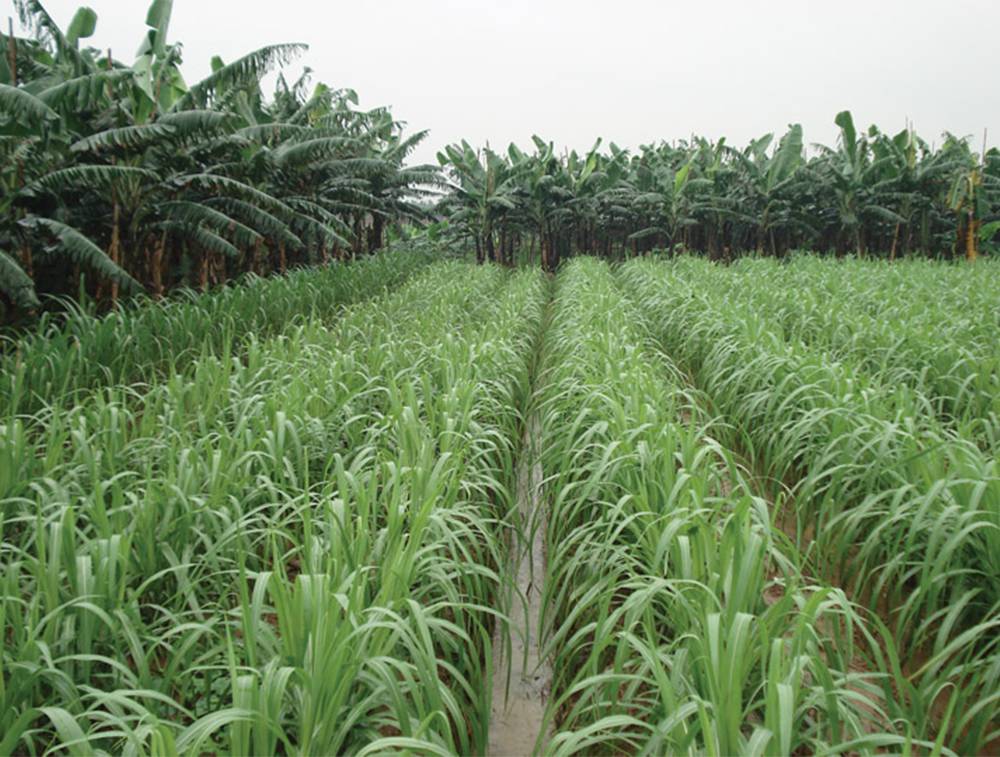
The Nitrous Oxide Emission Reduction Protocol (NERP) is a science-based approach that gives farmers a new way of benefitting from reducing their greenhouse gas emissions.
Nitrogen is used as a highly effective fertilizer but contributes 36% of greenhouse gas emissions in crop production. NERP was designed to manage crop nutrition and maximize yields, reduce greenhouse gas emission by 25%, and meet international standards for carbon offsets.
Through the NERP programme, farmers can earn carbon credits based on the reduction of nitrous oxide (N2O) generated through food production, associated with better nitrogen management. The concept and design of the NERP is simple and driven by data that producers are either already collecting or are interested in collecting to improve their overall farm management system.
Improved nitrogen management within NERP is delivered through the implementation of a 4R Nutrient Stewardship Plan. This means using the right source of fertilizer, at the right rate, at the right time, and in the right place. 4R Nutrient Stewardship plans provide farmers with science-based information and advice on how to use best management practices to reduce emissions of greenhouse gases and address other environmental impacts when they apply fertilizer.
“NERP gives farmers a game plan for reducing their emissions of N20, by outlining Best Management Practicess for sustainable fertilizer application,” comments Clyde Graham of Fertilizer Canada. “By applying “NERP” practices farmers see positive impacts on farm economics and environmental footprint.”
Reducing greenhouse gas per unit of crop produced, generating carbon offsets to help society adapt to climate change, and furthering farm profitability through improved return on fertilizer dollars spent, are examples of environmental, social, and economic goals that NERP helps Canadian farmers achieve.
Fintrac
Support to Grow Bamboo and Rattan Protects Forests
Cambodia

Since 2011, Cambodia HARVEST has promoted non-timber forest products as part of a multi-pronged approach to increase household incomes and incentivize communities to better manage and protect forest resources.
In rural Cambodia, bamboo and rattan are two of the most versatile raw materials. Villagers use them for a range of tasks: building and repairing their homes, making household objects like furniture, fencing, and fish cages, and supplementing their diets with the plant’s nutritious shoots. However, these two raw materials are scarce in many communities and villagers are forced to buy it at the local market or substitute timber products collected from nearby forests, endangering those areas.
The Cambodia HARVEST non-timber forest product component addresses two of the pillars of climate-smart agriculture: improvements in productivity and building resilience.
Cambodia HARVEST has increased the productivity of farmers producing bamboo and rattan by helping them implement improved nursery technologies, seedling propagation, large-scale commercial plantings, and community forest plantings in degraded areas. As a result, communities have more non-timber forest resources available to use on a sustainable basis, thus decreasing reliance on threatened tree species and increasing the resilience of community forests.
“This training was invaluable,” comments Suong Sokan, Chief of Khnar Pou Community Forest in Siem Reap province. “We’ve wanted to plant bamboo for a long time, but we just didn’t know how.”
The non-timber forest product component benefited 2,600 households in 30 communities, and Cambodia HARVEST has provided technical assistance to 69 non-timber forest product producer groups, which have evolved into small and medium-sized enterprises composed mostly of women. The groups increased their revenues by 430% and increased their profits by 535% over baseline.
Photo: Fintrac
iDE
Pioneering Solar Pump Provides Year-Round Irrigation
Zambia, Honduras and Nepal

To increase agricultural productivity and improve the livelihoods of smallholder farmers, iDE has developed a clean energy irrigation pump and delivery system called Clean Irrigation Solution (CIS). This was done with support from USAID’s Powering Agriculture Grand Challenge, and with partners PRACTICA Foundation and Futurepump. The CIS uses the Sunflower pump, an efficient, versatile, and cost-effective piston pump powered by a solar panel. The Sunflower pump is coupled with drip irrigation kits to maximize the agricultural output and value of each drop of water.
CIS allows farmers to produce crops all year-round, even in times of water stress and erratic rainfall, making them better equipped to deal with climate change. It strengthens resilience by providing an irrigation option for areas with limited water sources and low water table recharge rates. CIS reduces agriculture’s contribution to climate change because – as it uses no fuel – there is no direct contribution to greenhouse gas emissions.
iDE has carried out field pilots for CIS in Zambia, Honduras, and Nepal. Zambian farmer Olida, from Kaumba Village in the Southern Province, started using the pump in August 2015. Based on the results she saw, neighbouring farmers became interested in purchasing the pump themselves; either to reduce the amount they spend on fuel to run a motorized pump or to try an efficient water distribution mechanism in view of the current low water levels in the local stream.
“The Sunflower pump is better than other pumps as I only need sunlight to run it,” says Olida. “It also requires less labour and so I have even extended my cabbage patch this year. Before it would take me double the time and effort to water a smaller patch with buckets.”
Photo: Festus Hanankuni (iDE Zambia)
International Fertilizer Industry Association
4Rs of Nutrient Stewardship
Global
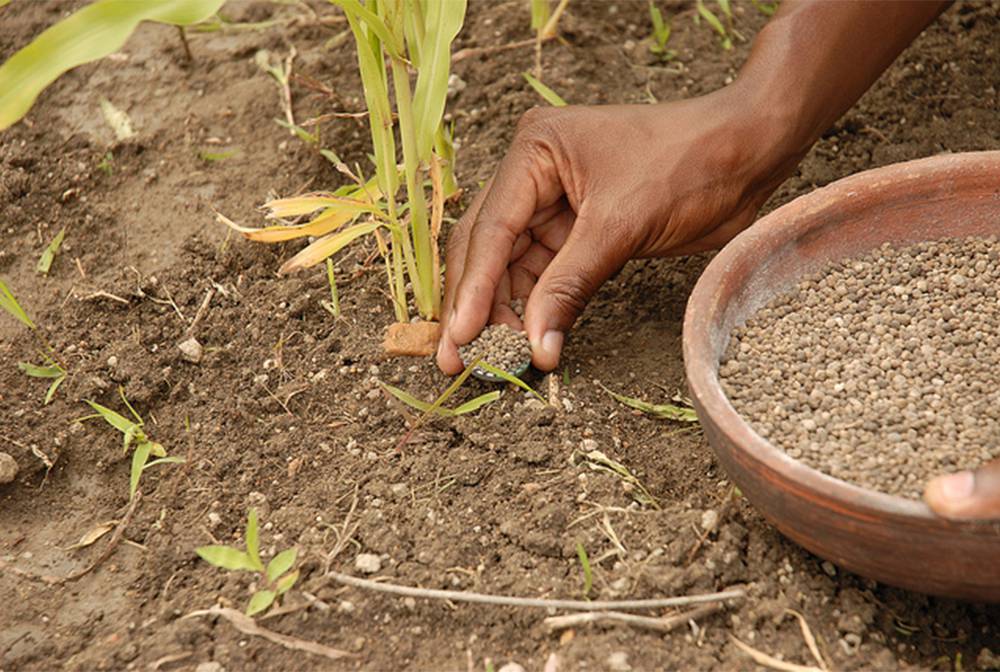
Fertilizer plays a critical role in maximizing crop yields, to satisfy increasing global demands for food. By helping farmers grow more on less land, it is also key to reducing deforestation and its associated greenhouse gas emissions – a major contributor to climate change.
The global fertilizer industry has come together to develop a system of stewardship to help farmers use fertilizer in the most efficient way possible. It is called “4R Nutrient Stewardship” and is based on four simple concepts: using the right source (or product), at the right rate, at the right time and in the right place.
Approaches that follow this framework are called “Fertilizer Best Management Practices” (FMBPs) and are based on scientific principles and applied research. Methods such as soil testing, application timing and the use of slow- and controlled-release fertilizers are all examples of how to put the 4Rs into practice.
The 4Rs help farmers to increase their economic outcomes, as they will spend less on fertilizer whilst managing to grow more, since the right fertilizer will maximise nutrient uptake and help the plant grow stronger. At the same time, less fertilizer will be lost to the environment, thus minimising both greenhouse gas emissions related to fertilizer use, and impact on the environment as a whole.
The application of FBMPs may differ widely depending on the region and socioeconomic context, however this system can apply to all farms across the globe, from the biggest to the smallest.
In Mozambique, for example, AGRA is helping farmers of the Zamo Ramambo farmer organisation test the fertilizer application processes that will yield the most maize. A precise dose of NPK fertilizer, measured in a cola lid and applied directly to the root is having the most beneficial impact, particularly when accompanied by lime which reduces soil acidity.
Photo: Alina Bossuet
IFDC
Scaling Up Fertilizer Deep Placement and Microdosing Technologies
Mali
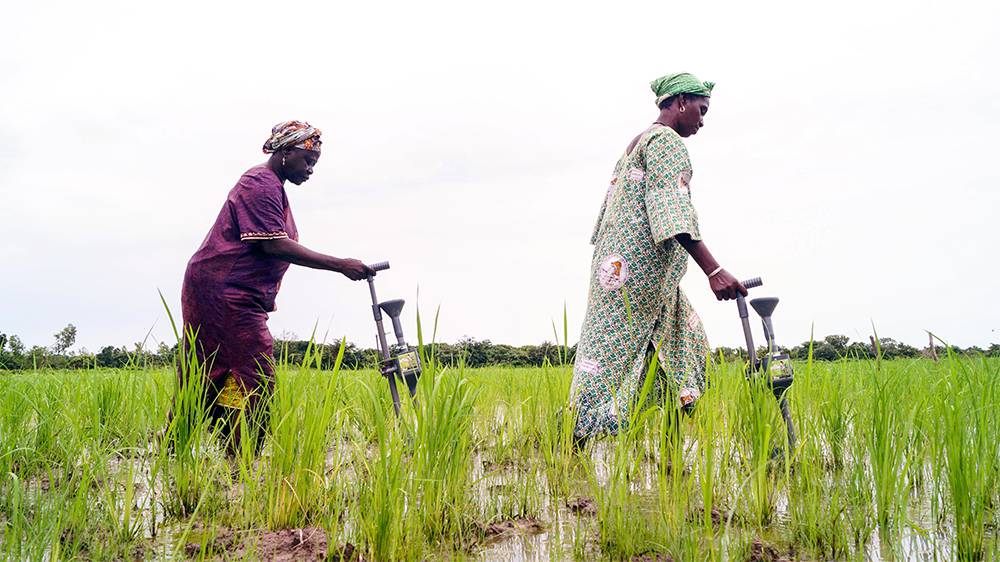
The USAID funded project “Scaling Up Fertilizer Deep Placement and Microdosing Technologies in Mali” promotes and disseminates innovative, climate-smart fertilizer-based technologies for targeted crops, including rice, millet and sorghum within the country.
The project introduces fertilizer deep placement (FDP) to Malian farmers, which involves placing a fertilizer briquette near the roots of the plant. This precise method of application reduces agriculture’s contribution to climate change by mitigating greenhouse gas emissions associated with fertilizer use, and increases productivity. Generally, FDP reduces fertilizer use by 33%, increases rice yields by 15% and incomes (for rice in Mali) by $573 per hectare, and reduces NO and N2O emissions.
The project also promotes microdosing, the application of very small amounts of fertilizer directly to plant roots. The method increases fertilizer efficiency and productivity of millet and sorghum crops.
Nearly 50,000 farmers involved with FDP-MD experienced an average yield increase of 2.67 metric tons per hectare in rice, as well as an increased production of crops valued at over $5 million in 2015.
One farmer in particular, Rokiatou Diallo, sees UDP (using a fertilizer briquette made from urea) as a way to bring food security to Mali. “The results [from UDP] were easy to see. On our demonstration plots, we saw a 20% increase in yield. And the miracle: we used 55% less fertilizer than before. The grains were also larger and of better quality.”
Photo: IFDC
International Food Policy Research Institute
Choosing the Tools to Fight Climate Change Globally
Global
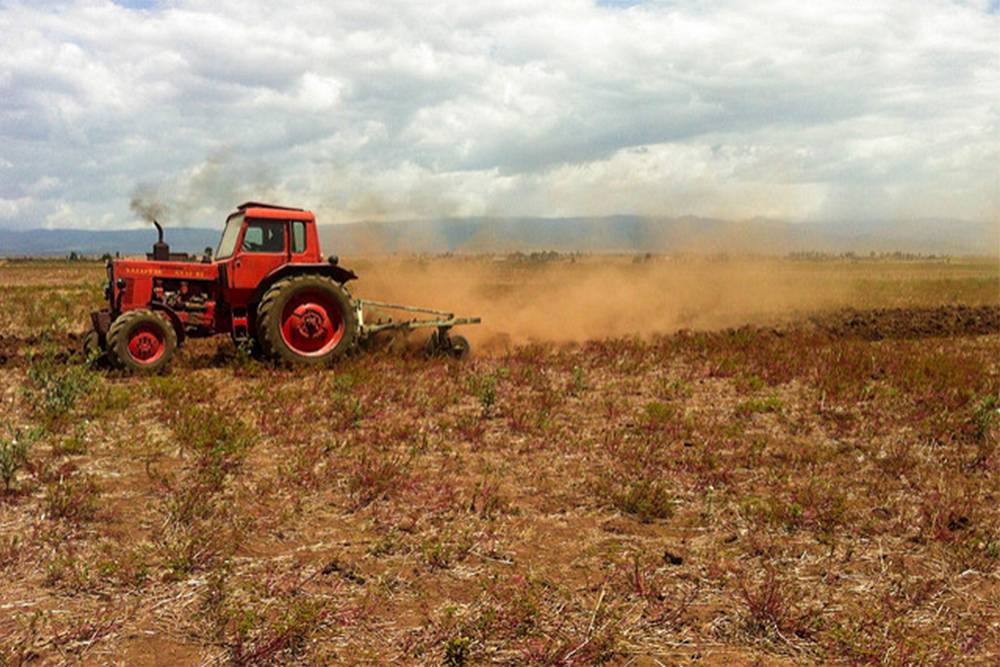
Which agricultural technologies will help farmers protect our food from the effects of climate change? With 9 billion mouths to feed by 2050, this is a critical issue in which policymakers should gain better visibility.
In 2014, the International Food Policy Research Institute (IFPRI) sought to answer this question and released a new study, “Food Security in a World of Growing Natural Resource Scarcity: The Role of Agricultural Technologies.” It examined how 11 agricultural practices and technologies could help farmers improve the sustainability of three of the world’s main staple crops – maize, rice, and wheat.
IFPRI used a premier data model to divide the world into 21,000 geographic sections. It was then able to pinpoint the agricultural technologies and practices that can most significantly reduce food prices and food insecurity in certain regions of the world.
The data showed that:
- No-till farming alone could increase maize yields by 20%, but also irrigating the same no-till fields could increase maize yields by 67% in 2050.
- Nitrogen-use efficiency could increase rice crop yields by 22%, but irrigation increased the yields by another 21%
- Heat-tolerant varieties of wheat could increase crop yields from 17% to 23 %with irrigation.
“The reality is that no single agricultural technology or farming practice will provide sufficient food for the world in 2050,” Mark Rosegrant, lead author of the report, explained. “Instead we must advocate for and utilize a range of these technologies in order to maximize yields.”
IFPRI launched an online tool, The Agritech Toolbox, along with the report, enabling policymakers to work directly with the study results and visualize how certain technologies can impact food security and natural resources at a global, regional and national level. This tool will be essential for policymakers in developing future agricultural investment strategies.
International Plant Nutrition Institute
Helping Farmers Reach Better Decisions for Fertilizer Use
South Asia

In South Asia, 90% of smallholder farmers using fertilizer do not achieve optimum crop yields due to a lack of access to soil testing services. In response to this information gap, the International Plant Nutrition Institute (IPNI) South Asia Program developed the Nutrient Expert® decision support tool that can rapidly provide fertilizer recommendations for individual farmers’ fields.
It is based on the 4R Nutrient Stewardship Principles, meaning it helps farmers apply the right source of fertilizer, in the right amount, at the right time and rate. This makes fertilizer use as efficient as possible, and reduces unnecessary loss of nitrogen as a greenhouse gas.
Farmers in India, Nepal and Pakistan are now using the Nutrient Expert®, which IPNI provides free of charge through its website in the form of a web or mobile app. Results have shown that farmers using the Nutrient Expert® to help manage fertilizer application on their farms have experienced an average yield increase in rice, wheat and maize of 1.2, 0.8 and 1.3 tons per hectare respectively.
“Just like a doctor who prescribes different medicines for different patients,” says Mr. Ramesh Prasad Singh from Sate-Bihar in India, “Nutrient Expert recommends appropriate nutrient doses for different farm fields leading to healthy crop and healthy soil.”
In addition to boosting food security in the region and reducing greenhouse gas emissions, the Nutrient Expert® is helping farmers grow crops that are more resilient to high temperatures, water deficits or pest and disease infestation, thanks to the balanced and adequate nutrition they are receiving.
Department of Agriculture, Food and the Marine, Ireland
The Beef Data and Genomics Programme
Ireland
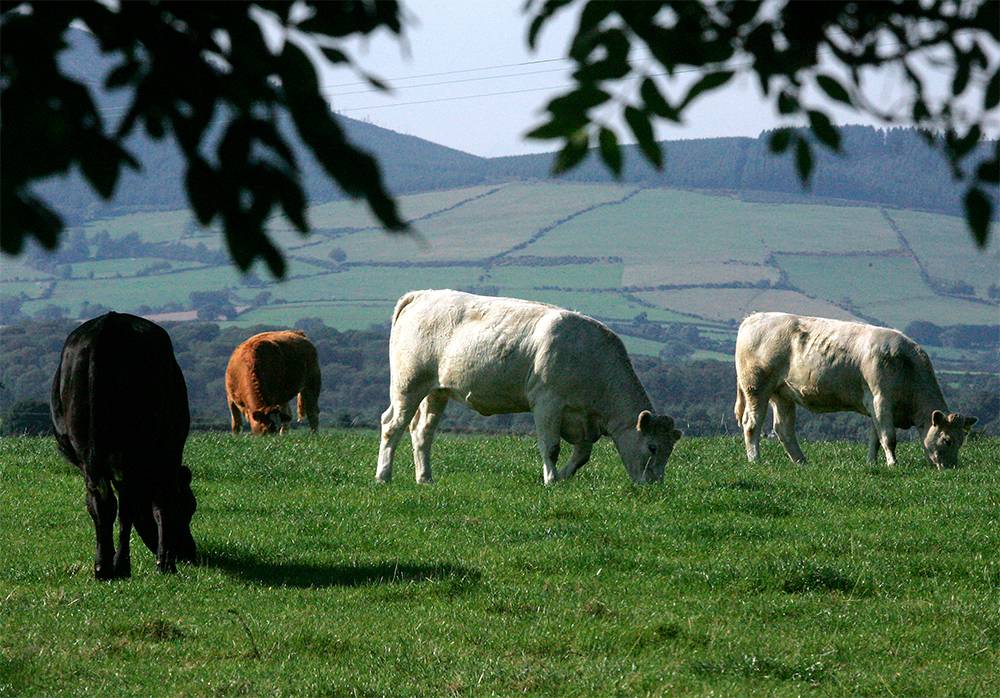
The Beef Data and Genomics Programme (BDGP) is funded by the Irish Exchequer and European Agricultural Fund for Rural Development (EAFRD) under Ireland’s Rural Development Programme 2014-2020. It was launched in May 2015, and will run for six years, with some 25,000 farmers applying for entry into the programme.
Participation is open to suckler beef farmers who undertake a number of programme actions that focus on lowering emissions via support for increases in herd efficiency. Research indicates that introducing genetically superior animals, in terms of improved maternal traits, can lead to measureable reductions in greenhouse gas emissions. For example, improving fertility reduces calving intervals and lowers the herd replacement rate thus reducing methane emissions per unit of product.
Programme actions include DNA sampling of breeding stock to establish a reliable genomic breeding index and to identify animals of superior genetic merit with lower associated greenhouse gas emissions. These animals are then utilised as replacement stock in BDGP participating herds. The programme also commits farmers to complete the Carbon Navigator tool for their farms, which builds on farm management data collected during an on-farm audit. It looks at practical areas, such as breeding and manure management, and identifies the potential impact of improved management on the farm’s environmental and economic performance. A training element of the programme provides information to farmers with regard to particular requirements at individual farm level.
In the preparatory analysis undertaken in designing the BDGP, greenhouse gas savings of between 86Kt and 300Kt of CO2 equivalent by 2020 were calculated. The benefits from the BDGP are permanent and cumulative, and larger gains can be expected post 2020 as the changed breeding focus takes full effect on the range of maternal traits addressed under the breeding aspects of programme.
Ithaka Institute
Farmers Learn to Turn Waste into Fertilizer
Nepal

Since late 2014 more than 200 Nepali farming families have learned how to make their own fertilizers using different waste materials. To create an effective nutrient carrier, farmers have learned how to carbonize an invasive shrub (Eupatorium, also called ‘forest killer’) or other crop residues using low or no-cost Kon-Tiki style kilns. Nearly 100 farmers have also built urine collection pits to collect livestock and in some cases human urine which is combined with charred biomass (also called biochar). Increasingly some farmers are also charring animal bones to add needed phosphorous to their soils.
Producing their own fertilizer from waste reduces costs for farmers. In addition, farmers are able to add long-lasting carbon to their soils, which has been shown to improve yields and sequester carbon in soils for hundreds of years.
To date, this urine-enriched biochar has been tested on many different crops including onions, potatoes, sugar cane, chilli, pumpkins, tomatoes, maize, cabbage, cauliflower, and more. Yield improvement varied amongst crops, but nearly all crops showed improvement. Some such as pumpkin had substantial improvement (364%) while others had a more moderate improvement (e.g. onions 18%, tomatoes 21%).
Ambika Aryal, a participating farmer, has seen her yield double. Ms Aryal earned $350 from her farm 100m2 plot, an important contribution to her family’s annual income. “We need to share the results with other farmers,” she comments.
The enriched biochar is also being used to plant forest gardens, which include tea plants, banana, coffee and other trees which will produce valuable products for farmers in an effort to boost rural economic development and has improved tree survivability substantially.
Livelihoods Fund
Promoting Agroforestry & a Sustainable Dairy Cycle
Kenya

Deforestation, uncontrolled grazing and soil erosion are having a negative impact on biodiversity and soil fertility in the lands upstream of Lake Victoria in Kenya. Crop yields & milk production are very low and farmers have no sustainable connections to markets.
A new project, launched at the beginning of 2016 in the Mount Elgon area, seeks to reverse this trend. Funded by the Livelihoods Fund, it is implemented by the NGO VI Agroforestry. It involves 30,000 farmers and covers 20,000 hectares.
The project aims to implement sustainable agricultural practices to help farmers:
- Produce more and better – by enhancing soil fertility with agroforestry and crop diversification,
- Increase milk production – by providing feed for cows all year (fodder production by farmers themselves) thus avoiding uncontrolled grazing,
- Preserve the ecosystem and water resources – by planting trees which prevent soil erosion (boosting Lake Victoria’s resilience) and sequester CO2
In conjunction, a partnership has been signed with Brookside, a local milk company in which Danone owns a stake, to buy milk produced by the participating farmers over the next 10 years. Brookside will also support milk cooperatives by providing milk collecting services and cooling tanks.
The project is expected to increase yields on subsistence & cash crops by 30% for farmers. The partnership with Brookside will sustain farmers’ livelihoods in the long term: dairy farmers’ revenues will double and the project will involve women in 1200 farmers’ groups. In total, the project is expected to sequester around 1 million tons of CO2.
Photo: Livelihoods Venture
LTO
Agro Covenant on Target in the Netherlands
Netherlands
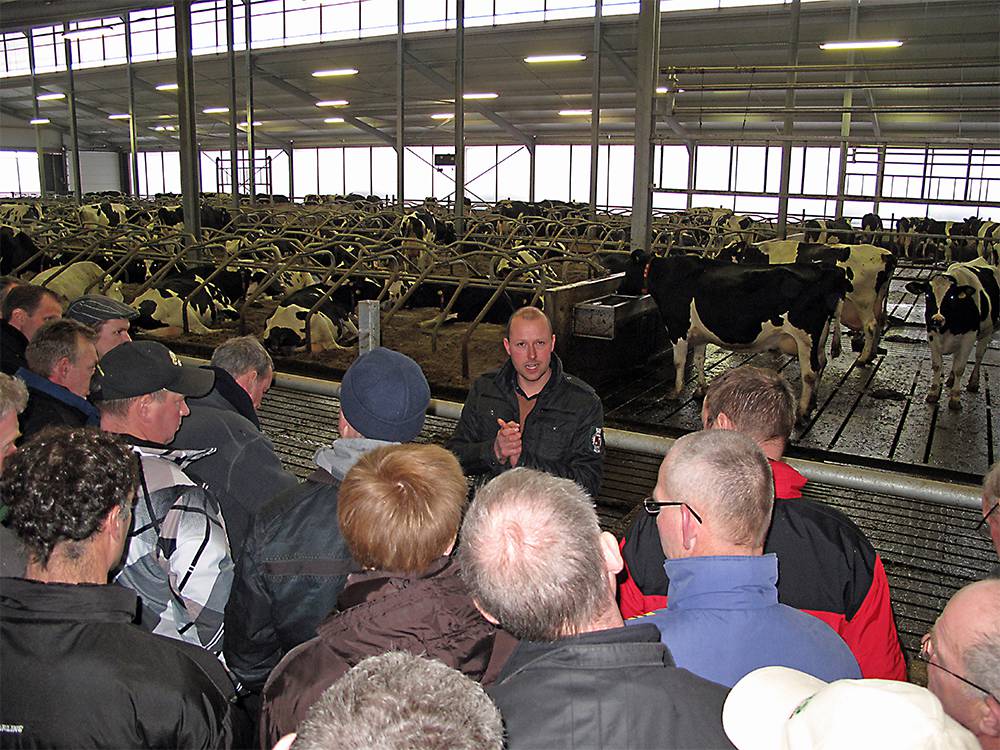
In 2008, the Dutch agro sectors signed a Public-Private Partnership with the government entitled ‘Clean and Efficient Agro Sectors’, or the ‘Agro Covenant’ for short, setting out pledges to make the sectors more sustainable by 2020. It aims to help achieve the national targets to which the Netherlands has committed itself in the European framework.
Targets include reducing CO2 emissions in 2020 by at least 3.5 Mt and other greenhouse gases like methane and nitrous oxide by 4.0 to 6.0 Mt (in CO2-equivalents). In addition, 200 petajoules of renewable energy from biomass must be produced per year, as well as 3.5 billion kilowatt-hours per year of wind energy.
The aim of this agreement is to use the competitive and innovative power of the companies concerned to achieve the targets. The prime focus of policymakers is therefore not on implementing legislation and mandatory measures, but on coming to agreement on achievable goals. Companies and sectors are then at liberty to meet the targets as they best see fit from their own particular business perspective.
Examples include collaboration between greenhouse horticulturalists and livestock farmers in the field of methane digestion. A pilot project has set up digesters for manure, and used the biogas and warmth of the digesters to heat greenhouses. This might result in cooperation in the nearby future.
In ways like this the agro-sectors are becoming local and regional energy producers; farmers are now responsible for 42% of the production of sustainable energy in the Netherlands. The results show that the ‘Dutch way’ works and all the agro-sectors are now well on track when it comes to energy efficiency.
One Acre Fund
Compost Trainings that Fight Poverty and Boost Resilience
Kenya, Rwanda, Burundi and Tanzania

Founded in 2006, One Acre Fund is a nonprofit social enterprise that provides over 400,000 farmers in Kenya, Rwanda, Burundi and Tanzania with the tools, financing, and training to grow their way out of hunger and poverty. Now in its tenth year, One Acre Fund is sharply focused on its long-term impact and is dedicated to making sure that the methods it teaches improve soil health and resilience wherever possible.
One way it does this is through composting trainings. By creating and applying compost, farmers are able to return much-needed nutrients to their fields, protect their soil from erosion, and improve their yields. These trainings align with the pillars of Climate Smart Agriculture, helping farmers sustainably increase their productivity and incomes while also enhancing their resilience to and protecting against environmental shocks. When a farmer’s soil is healthy, her crops are more likely to withstand disease, pests, and fluctuations in weather—environmental factors that could otherwise decimate an entire harvest.
In 2013, Rwandan farmer Ezira Ntegeyimbuga began composting for the first time, using the techniques he had learned in One Acre Fund’s composting training. That season, he harvested 80 kilograms of beans and 180 kilograms of maize and set a new record for the best harvest.
“The compost training saved me from poverty and hunger,” comments Ezira. The skills I learned from One Acre Fund were just the beginning. I now have to turn my skills into money.” Now, he uses the knowledge he gained from One Acre Fund’s trainings to make and sell compost to his neighbours.
Photo: Evariste Bagambiki (One Acre Fund)
Rainforest Alliance
CO2 Coffee Project
Mexico
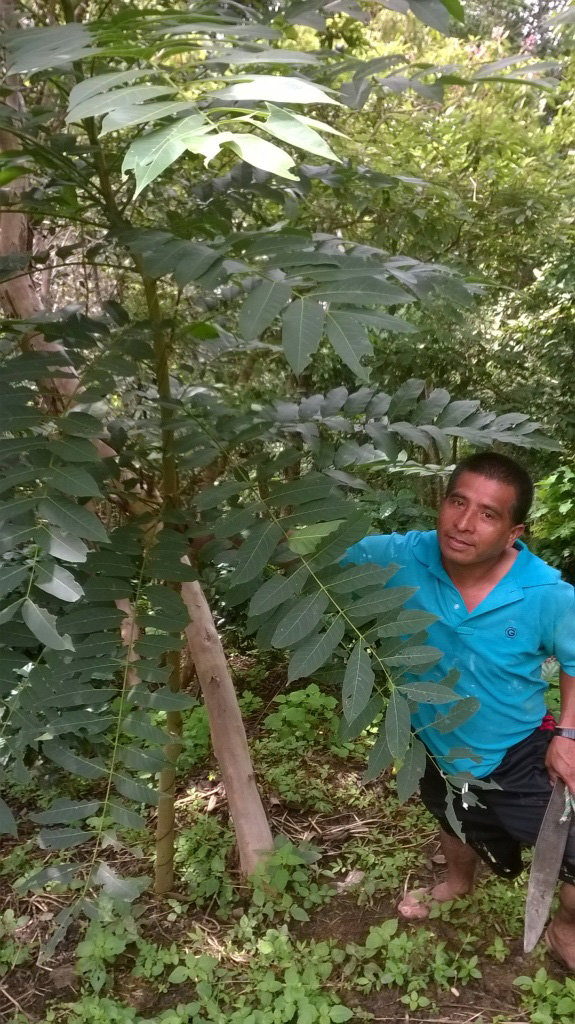
The CO2 Coffee project is designed to combat deforestation and mitigate the effects of climate change while also supporting communities seeking to improve their livelihoods. In collaboration with a local coffee cooperative and other partners, Rainforest Alliance is working with roughly 400 coffee farmers in Oaxaca’s Chatina and Zapoteca regions to: protect the region’s remaining forests; reforest degraded areas; promote the long-term sustainable production of coffee and increase their crops’ resilience to the impacts of climate change.
The farms involved in this project are located in the Santa Lucía Teotepec, San Juan Lachao Nuevo, Santa Rosa de Lima and Soledad Piedra Larga communities and are already Rainforest Alliance Certified™, meaning that farmers have met the rigorous standards of the Sustainable Agriculture Network (SAN) and adhere to on-farm methods that reduce waste, protect local ecosystems and promote social and community benefits. With the help of locally community technicians trained by the project, they are reforesting fallow farmland and increasing shade cover in their pasture areas and within their coffee farms by planting a mix of native timber and fruit tree species. These measures promote soil fertility, maintain the connectivity of wildlife habitat, and provide a valuable and sustainable supply of timber and fruit.
“To improve the soil, to make the most of the rain, planting more trees gives us more moisture, more oxygen and helps address global warming” comments Leandro Salinas, a Community Leader and farmer from the UNECAFE co-operative.
In addition, the project is officially registered with the Verified Carbon Standard (VCS), which establishes stringent protocols for assessing the project’s impacts on greenhouse gas emissions. Once verified, the farmers will be able to sell carbon credits on the voluntary market, and the project will become the first smallholder VCS reforestation project in Mexico to sell carbon credits.
Root Capital
Investing in the Future of Coffee: Financing for Farm Rejuvenation
Peru

Since 2010, Root Capital, an agricultural impact investor, has been working with the Peruvian coffee cooperative Chirinos to promote farmer adoption of climate-smart practices. With the help of several multi-year loans from Root Capital, Chirinos has invested in new services to improve the productivity and, ultimately, the long-term resilience of its members’ coffee farms, while sustaining climate-smart agroforestry production systems.
First, in 2010, Chirinos built a state-of-the-art fertilizer plant. The cooperative uses the facility to transform farmer members’ waste coffee pulp into fertilizer, which it then distributes at an affordable price. Called Pachakushi, a Quechua word meaning “happy soil,” the fertilizer facility helps farmers build soil health, resulting in short-term yield increases of up to 60% and likely longer-term benefits of increased resilience to extreme weather events.
“We’ve increased our productivity with this fertilizer,” comments Nilter García Chimbo, a Chirinos Agronomist. “[It] is better than what we had before, when our farmers maybe produced 10-15 quintales of coffee per hectare, and now we’re averaging 23 quintales per hectare in the area of Chirinos.”
More recently, Root Capital provided Chirinos with a multi-year loan to finance the rejuvenation of its members’ agroforestry coffee farms. By pruning or grafting old or diseased coffee trees, farmers can significantly increase their productivity and improve their bottom line. In the process, Chirinos and Root Capital sustain agroforestry production systems that can increase farmer resilience to climate change, while serving as important biodiversity corridors and carbon sinks in a region with significant, ongoing forest loss.
Root Capital believes that “right-sized” finance for climate-smart investments, like fertilizer facilities or farm replanting, will be critical to ensuring that climate-smart, agroforestry systems like coffee remain viable for smallholder farmers.
Photo: Root Capital
World Vision
Eco-Agriculture in the Sahel
Mali

World Vision, with support from the Margaret A Cargill Foundation, is implementing the Eco-Agriculture in the Sahel project to improve community resilience, farmer livelihoods, and environmental stewardship. This is being done through adoption of Farmer Managed Natural Regeneration (FMNR) and complementary soil and water conservation (SWC) and conservation agriculture (CA) practices in targeted areas in Mali.
FMNR restores degraded agricultural lands and pastures, enriching soil, reversing desertification, enhancing groundwater recharge, and contributing to reforestation. Naturally regenerated trees, when properly managed, serve as a “simultaneous fallow” alongside growing crops, helping restore soil organic matter and soil cover through leaf litter. These trees also improve the soil’s ability to absorb moisture, and reduce erosion from wind and water. Dispersed shade provided by trees increases crop production by reducing the ill effects of extreme sunlight and high temperatures.
Increased availability of sustainably harvested firewood reduces the impact of women using crop residues for cooking fuel, further enhancing soil cover and organic matter and reducing the labor and expense of gathering wood far from home.
“We are satisfied with the impact of the regeneration of the village lands,” comments one female farmer from the village of Endé. “Today, all the wood we use for cooking comes from the village lands.”
FMNR-led agro-ecological farming practices also directly help landscapes adapt to climate change, as the natural environment is better able to cope with more variable precipitation, with both trees and carbon-rich soil acting as carbon “sinks.” SWC practices such as contour bunds and CA also improve water infiltration in soil, and soil fertility, and thereby increase the productivity, sustainability, and resilience of agriculture-based livelihoods. To date, 18,000 households have been targeted.
World Resources Institute
Restoring 20 Million Hectares of Degraded Land
Latin America and the Caribbean
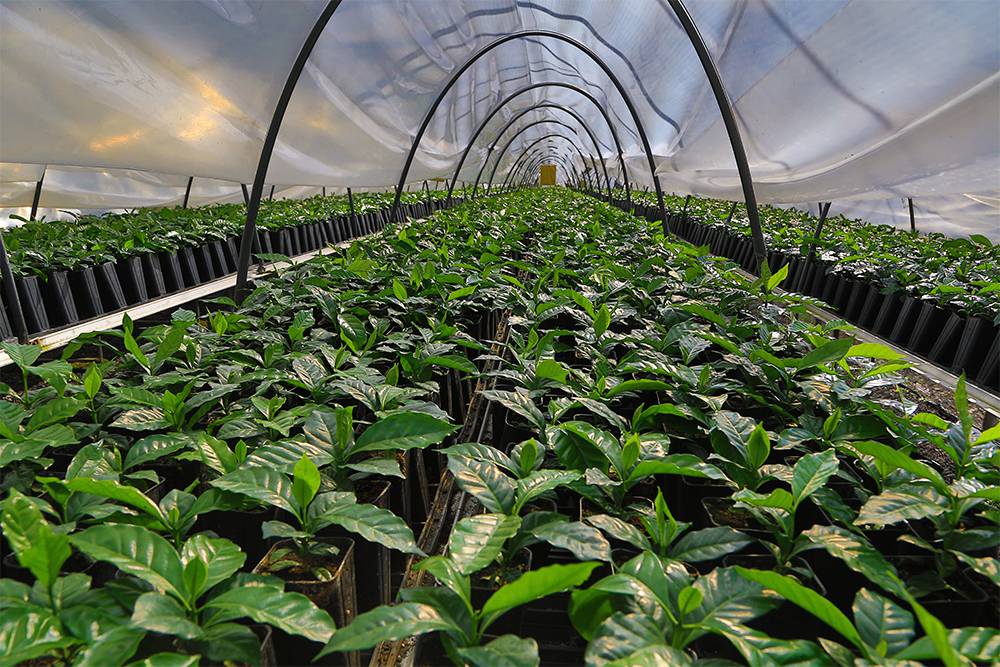
Initiative 20×20 aims to bring more than 20 million hectares of degraded lands in Latin America and the Caribbean into restoration by the year 2020.
The Initiative was launched in COP 20 in Lima, Peru, in December 2014 where eight countries and five investment groups announced their ambitions to restore degraded lands and to invest in restoration projects in the region. As of today eleven countries, ten investment partners, three Multilateral Banks and sixteen technical partners have joined the Initiative.
Both the agriculture and forestry sectors are key to commerce, employment and local livelihoods and of the Latin American and Caribbean region. Initiative 20×20 seeks to balance the production needs with the sustainable use of lands through approaches that include silvopasture, agroforestry and low carbon agriculture and reforestation.
Initiative 20×20 partners undertake landscape restoration activities through multiple approaches. Countries play the lead role in restoration, independently setting their restoration targets and opting to include them as a contribution to the goals of Initiative 20×20. This ensures that the paths that each country sets are part of the national priorities, resulting from an internal process.
In Nicaragua for example, coffee production has been severely affected by drought and leaf rust. Agroforestry offers a solution to stabilize the production of coffee, as it combines trees and crops or animals that signify improved ecosystem interactions leading to better resilience. In partnership with NicaFrance, The Moringa Fund has launched the NicaFrance Outgrowers Project, creating a farmers cluster around La Cumplida, the largest independent coffee farm in Nicaragua. La Cumplida covers over 1,800 hectares including agroforestry land, primary forests in conservation, and hardwood timber production land. Overall, the farm will allow sequester 500,000 tons of CO2 and create up to 6,000 jobs.
Food and Agriculture Organization of the United Nations (FAO)
Drought Tolerance Tools Boost Yields and Resilience
Gambia
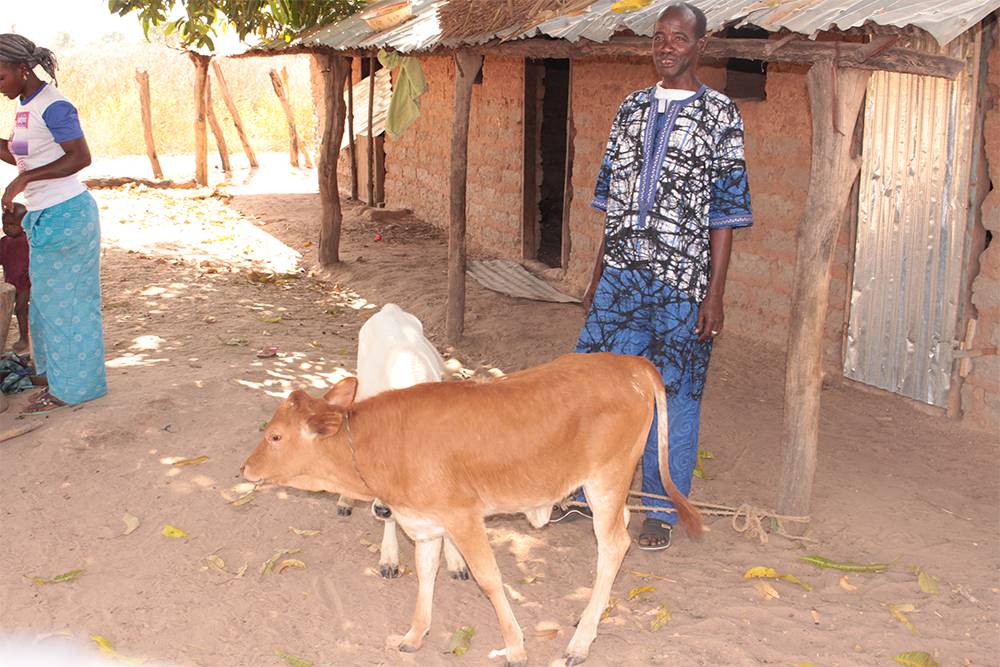
In June 2013, in partnership with the Ministry of Agriculture, FAO began implementing a three-year European Union-funded project geared towards achieving Target 1C of the Millennium Development Goals. FAO Gambia sets about doing this through sustainable intensification and diversification of small-scale agriculture. Farmers received training in good agricultural practices, high-quality inputs (such as seeds of drought-resistant crop varieties and fertilizer) and ploughing services. They were also provided with support to produce their own drought-resistant seed material and to adopt safe storage practices under increasingly extreme weather conditions. This has built resilience into local production systems, allowing greater self-sufficiency in access to high-quality seed and mitigating the risks of more frequent and pronounced droughts.
The increased productivity has allowed farming communities to cover their household consumption year-round and sell surplus on the market, whereas previously they often exhausted their produce in three to six months. The additional revenue allowed farmers to invest in fertilizer loan revolving funds established at the farmer-based organizations’ level.
Mariama Sillah, 45, President of the Darsilami Women Vegetable Garden, Sandu District, URR, said that thanks to the intervention “I am economically empowered”. She noted that most of the women have opened bank accounts while others have bought livestock.
Community vegetable gardens were also established, which deliver high-value marketable produce and also improve the nutrition of the communities. The gardens are equipped with solar irrigation pumps ensuring sufficient water supply without creating additional greenhouse gas emissions.
To date, the “MDG1c Project” has directly supported 10,730 small-scale farmers in 140 communities to increase their resilience to climate change and improve their food and nutrition security. Yields and farm income have increased by 67% on average.